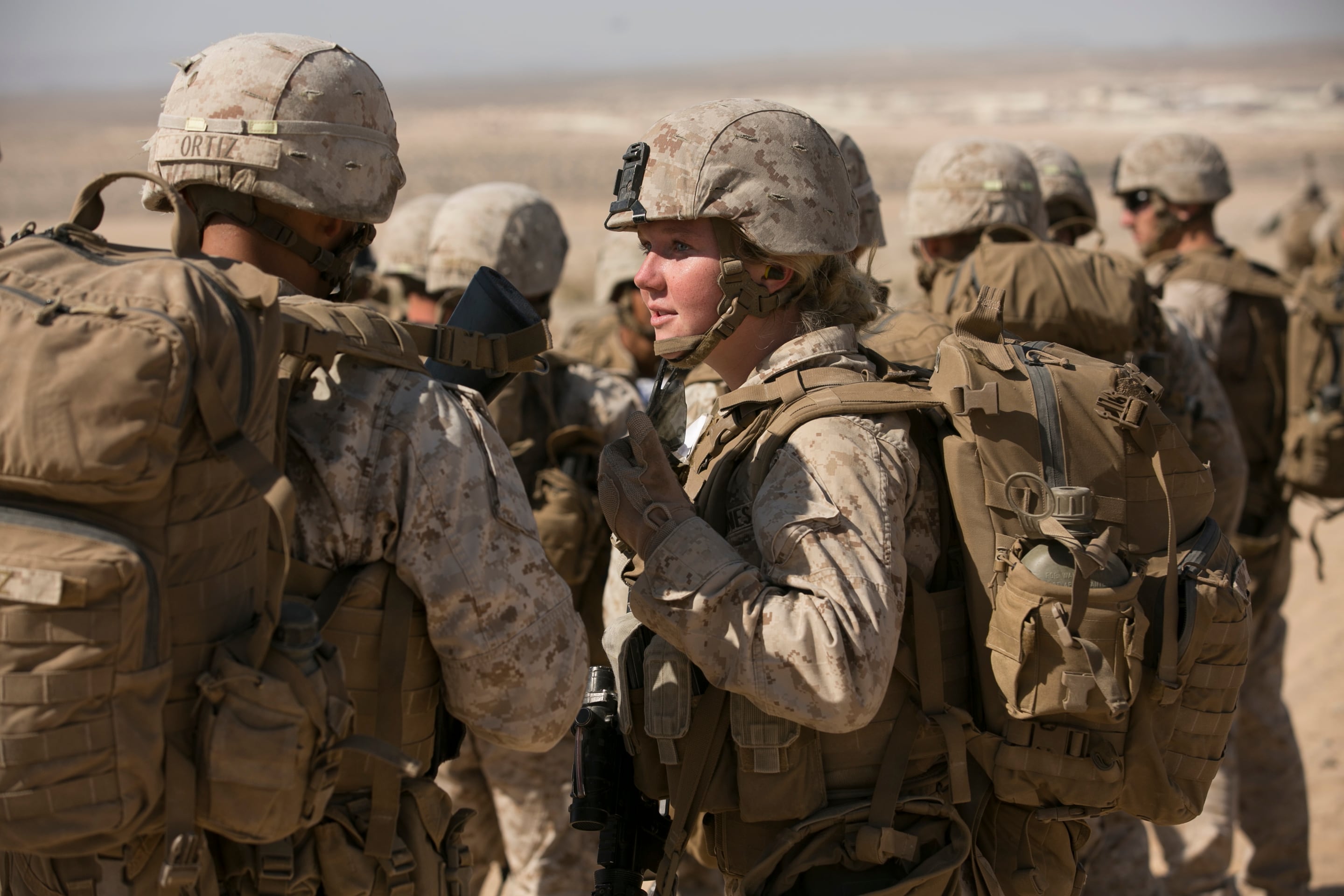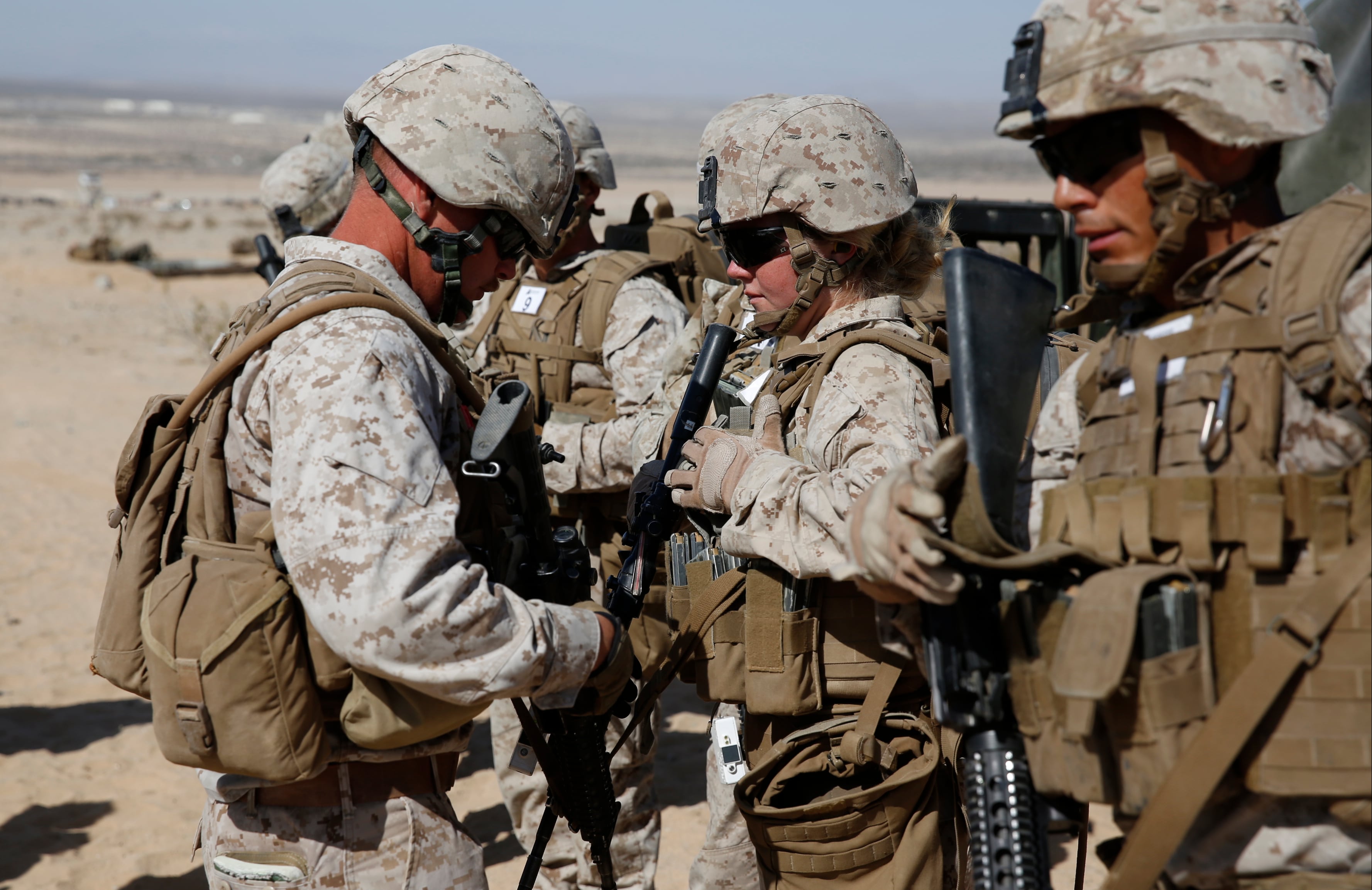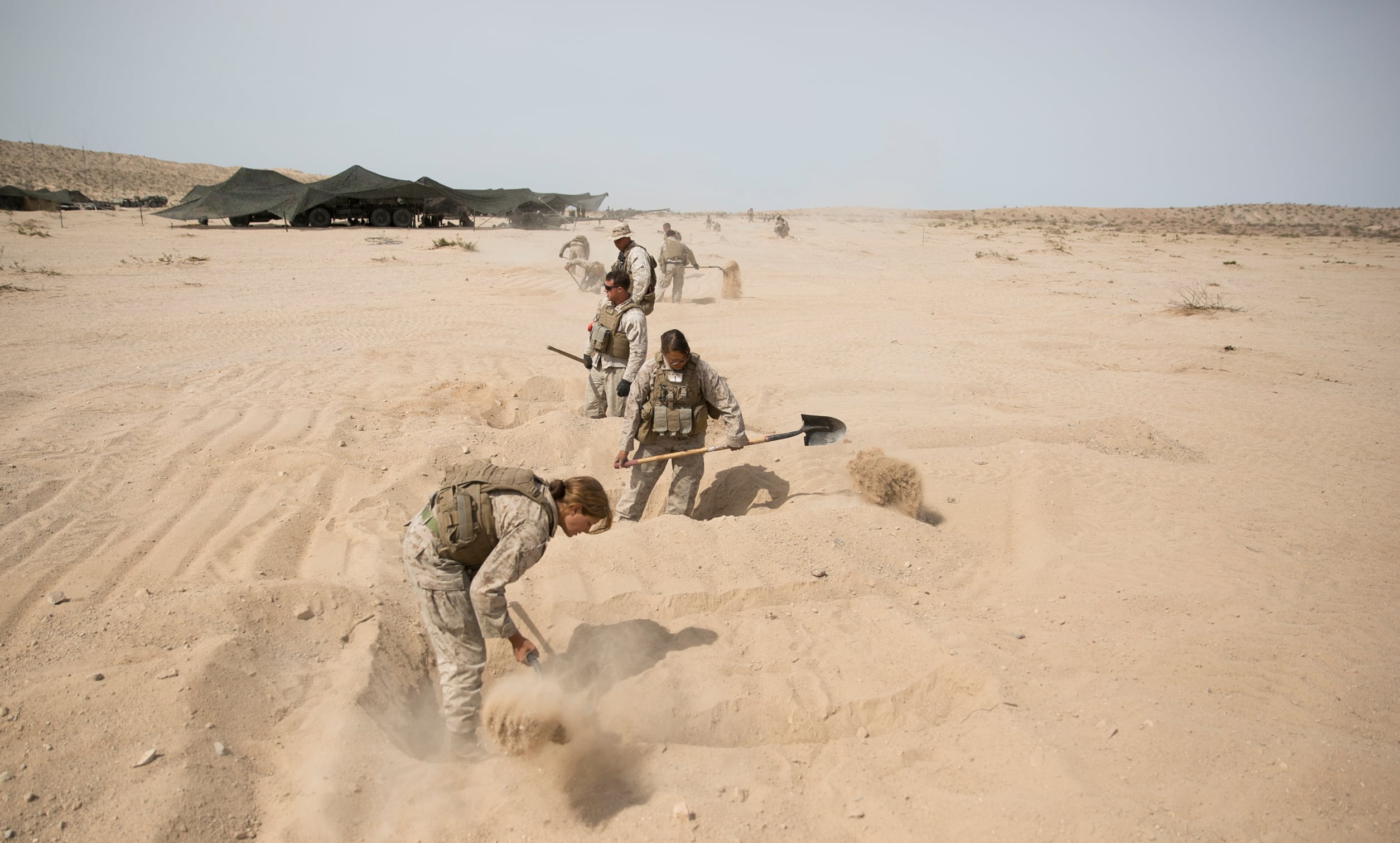Lance Cpl. Callahan Brown kept losing her tentmates.
The 20-year-old Marine had spent months in co-ed training at Camp Lejeune, North Carolina, before moving west to Marine Corps Air Ground Combat Center Twentynine 29 Palms, California, for a series of combat assessments in grimy field conditions — the closest any female Marine has been permitted to get to infantry life and training.
And now sShe watched as the number of women involved in the experiment her female peers dwindled by the day.
"I was stressing out because all my girlfriends started getting hurt," Brown told Marine Corps Times. "They're all getting this common injury from hips. I was waiting to feel something in my hips and I never did."
According to Brown and other members of her unit, she was one of just two women left standing in the in the task force's pair of two infantry-trained rifleman platoons at the end of the to complete the full nine-month-long experiment, she and other members of her unit said. Most of the other women in those two platoons had been dropped or task force training and assessment period without dropping the course or getting temporarily sidelined with light duty due to injury.

Lance Cpl. Callahan Brown talks with a fellow Marine with the Ground Combat Element Integrated Task Force after an infantry assessment at Marine Corps Air Ground Combat Center Twentynine Palms, Calif. Brown was one of two female Marines with infantry platoons who remained at the end of the months-long experiment.
Photo Credit: Mike Morones/Staff
While Marine task force officials declined to have not provided any figures on the makeup of the units, it has been reported that there were roughly two dozen women were in the infantry company when the task force activated.
Marine officials are expected to make data and findings collected from the task force experiment public in coming weeks. Ahead of official results, however, male and female task force participants told Marine Corps Times that only a small number minority of female volunteers proved capable of taking on the more physically demanding combat jobs. And some volunteers reported perceived unequal treatment that broke down unit cohesion and fostered resentment between male and female counterparts.
With the Army's Sept. 2 announcement that it will open Ranger training to female soldiers and Navy Secretary Ray Mabus' recent statement this month that he supports full combat integration within the Marine Corps, the chance of seeing all fields open to female Marines at the start of next the new year seems increasingly likely.
In light of that, these revelations accounts from Marines who participated in the groundbreaking experiment at Lejeune and Twentynine Palms task force volunteers raise questions about how many women are able — and willing — to make it as a grunt. are likely and able to choose a ground combat career, given the chance --
The experience has even left some participants questioning whether Perhaps more and if the Marine Corps is ready for the cultural and organizational challenges of gender integration.
The ground combat experimentThe Marines' gender experiment
While all the military services face the same Jan. 1 deadline to open closed combat jobs to women or argue for specific exceptions, the Marines' approach to the question of integration was unique in its rigor.
The Ground Combat Element Integrated Task Force turned training bases into laboratories, hooking Marines like Brown volunteers up to heart-rate monitors and GPS devices. Their rifles were rigged and rigging rifles with devices that could determine the placement, accuracy and timing of every shot. Some 400 Marines, including about 100 women, signed up to be task force test subjects.
They were divided by military occupational specialties representative of those in the ground combat element of a traditional Marine air-ground task force: infantry; weapons; artillery; and mechanized units, including tanks and other armored vehicles. A provisional rifle platoon rounded out the unit, allowing Marine officials to assess and compare the performance of Marines who had received no formal infantry training with those who had completed Lejeune's Infantry Training Battalion, including some of the first female graduates.
After a series of athletic tests and functional screenings administered by researchers from the University of Pittsburgh, Marines volunteers embarked on a four-month training period at Camp Lejeune. There, leaders that reinforced small unit-level training and readiness standards for each MOS military occupational specialty being evaluated.

Marines complete an infantry assessment at Marine Corps Air Ground Combat Center Twentynine Palms, Calif., in April. Data collected from the task force will help Marine leaders decide whether to request exemptions to a Defense Department-wide mandate that will all military jobs to women.
Photo Credit: Mike Morones/Staff
The entire unit then "deployed" to the California desert to 29 Palms for a repetitive series of assessments conducted under human testing conditions that attempted to simulate the toughest physical requirements for each combat MOS.
The goals of the task force were twofold. First, the data will be provided to the cCommandant Gen. Joseph Dunford in order to to assist in his a decision about whether to request exceptions to the integration mandate. It will also be used and to establish a baseline for gender-neutral physical standards that the Marine Corps can apply in the future to the infantry and combat jobs that open to women become co-ed.
But even with the clinical approach to testing, there were challenges from the outset, several Marines said.
While many male volunteers had years of experience in their given combat MOS under their belts, the female volunteers either came from non-combat units or were straight out of directly from boot camp and follow-on infantry training, making them significantly less experienced in their new roles compared to and sometimes more junior than their male counterparts.
That is dynamic could help to explain, in part, why participation in the task force was a cold wake-up call for some.
'It really sucked' Two in ten
Cpl. Janee' Sheffield knew she was done when she kept rolling the same ankle over and over on daily hikes, leaving her in constant pain. She dropped on request from the task force's provisional rifle platoon — made up of Marines who had not attended ITB — six days before the unit completed its round of assessments at Twentynine 29 Palms and traveled to nearby Bridgeport, California for mountain warfare exercises.
Like the other rifle platoons, the provisional platoon was on a repetitive cycle that alternated between two assessment days: a movement-to-contact exercise in which Marines troops would charge 1,000 yards up a hill with weapons and 30-pound packs, scramble over an 8 eight-foot shipping container and maneuver together toward simulated enemy fire while shooting at pop-up targets; and a hike day involving a roughly 4.5-mile 7-kilometer march followed by two arduous hours digging fighting holes.

Marines with the artillery section of the Ground Combat Element Integrated Task Force dig fighting holes during a timed assessment at Marine Corps Air Ground Combat Center Twentynine Palms, Calif. Some male Marines say they were overworked during the experiment as the women were unable to keep up.
Photo Credit: Mike Morones/Staff
Well bBefore opting out of the task force she left the unit, Sheffield, 23, had decided the infantry wasn't for her.
"It sucked; it really sucked," she said. "I wouldn't do this experiment again."
Within the integrated rifle platoons, Sheffield and other volunteers said unit cohesion actually became quite strong. In dirty and charmless field conditions, male and female Marines alike got serious about the tasks at hand and developed close sibling-like relationships, they said. But Sheffield said most of her female colleagues in the unit agreed with her by the time the assessment was done. It wasn't for them, she said : this isn't for me.
"Over time, your body breaks down," Sheffield said. "Our backs were hurting. Out of 100 female Marines, I'm going to say a good 20 could do this."
Infantry platoon volunteer Sgt. Jeremy Bradshaw arrived at exactly the same conclusion about women capable of living the grunt life same estimate following his time in the task force.
"It's a very small number; I'd say two out of 10," he said.
While videos and photographs released by the Marine Corps show women task force showed female Marines excelling at combat tasks, Bradshaw he said they omitted the moments of failure. He watched a four-woman team struggling for more than seven minutes to move a 200-pound dummy, without success, he said. Another time, he said, or female Marines failed ' fruitless efforts to clamber over the top of the shipping container during movement-to-contact assessments.
A reservist from Delta Company, 4th Light Armored Reconnaissance Battalion, company, 4th LAR, Bradshaw acknowledged that his years of infantry experience gave him a performance advantage over female Marines coming directly to the task force from the School of Infantry and learning in real time how field operations differed from the basics learned in school. And the repetitive grind of the assessment days was hard for the men, too, he said. In the first few days at Twentynine 29 Palms, he said 12 members of his platoon — 10 men and 2 women — male and 2 female, dropped from the unit for various reasons.
Because everyone in the platoon had graduated from ITB received enlisted infantry training, Bradshaw said the experience raised serious questions about whether existing standards were stringent enough to select Marines who were cut out for success as a grunt.
"When the commandant came to visit us out at the range one day, he asked how many Marines felt that [infantry training] is adequate," he said. "Half raised their hands."
A change of heart 'A fundamental change'
Lance Cpl. Chris Augello arrived at the integrated task force believing that women should get a shot at service in the infantry as long as they could meet existing standards. It was a perspective that made him different from most male Marines, he said, and he'd argued with his unit members for hours on the point.
When Augello checked out of the task force months later earlier this year, however, he submitted a 13-page essay to unit officials explaining exactly why the experience had made him change his mind.
Another reservist from Delta Company, 4th LAR, Light Armored Reconnaissance Battalion out of Quantico, Virginia, Augello, 23, said he volunteered for the task force for personal reasons — namely, a chance to accrue the six consecutive months of active duty that would qualify him to take advantage of the post-9/11 GI Bill.
He was assigned to At the light armored vehicle platoon once he got to Camp Lejeune. Over time, where he spent his task force days, he said, discipline broke down because some noncommissioned officers were hesitant to hurt the feelings of more junior female Marines with orders or correction. Romantic relationships and friendships between male and female unit members also became a distraction, he said.
"The female variable in this social experiment has wrought a fundamental change in the way male NCOs think, act and lead," Augello wrote in the 13-page paper he presented to Marine leaders, which he shared with Marine Corps Times his paper. "A change that is sadly for the worse, not the better."
Physically, both the men and women in Augello's the platoon fared well. No one was dropped due to injury over the course of the experiment, unit members said. But the lance corporal Augello said he became frustrated during group assessments, such as an exercise in which platoon members had to work together to haul a dummy weighing nearly 200 pounds out of the vehicle turret and to a designated recovery spot dozens of yards away. When partnered with the platoon's female Marines, he said he frequently had to compensate for their smaller frames and lacking of lesser upper body strength by hauling more of the load.
"I told myself, 'I don't know how much longer my back will have after doing this,'" he recalled.
During one assessment, Augello said he found himself paired with the smallest male Marine in the platoon — one who was physically shorter and slighter than a number of the unit's female Marines. But the Marine's build and musculature made a significant difference, he said.
"I didn't feel a lot of stress on my back because he was able to actually help me," he said. "His upper body strength made the difference at the end of the day."

Cpl. Caroline Ortiz, a Marine with the Ground Combat Element Integrated Task Force, gets a hand with lifting a shell during an artillery assessment at Marine Corps Air Ground Combat Center Twentynine Palms, Calif.
Photo Credit: Mike Morones/Staff
Asked about Augello's assertions, Marine Corps spokesman Capt. Philip Kulczewski said forthcoming task force data would illustrate describe individual Marines' opinions of fatigue, workload and unit cohesion, though he declined to provide the data ahead of an official coordinated Marine Corps release. Kulczewski also He refrained from commenting on Augello's observations about unit dynamics.
"Thorough objective data and comprehensive survey information was collected," Kulczewski said. "Not anecdotes."
Augello's observations regarding unit cohesion likely shed more light on upcoming challenges for the Marine Corps regarding enforcement of discipline and professionalism than they do on universal truths about dynamics in integrated combat units.
Another member of the LAV platoon, Sgt. Curtis Clifton, said he felt some of the problems in the unit were inevitable. Female volunteers fresh from school were given crew tasks that fleet Marines often worked for a year to earn, which he said he believed helped to foster a sense of elitism among some.
They also struggled to develop a serious "combat mindset" about their daily tasks, he said, likely because they lacked significant fleet and combat experience.
And for male Marines accustomed to ground combat units, Clifton said, working with women every day proved to be a distraction to which that they needed to become accustomed to.
"In the task force yYou had a whole bunch of guys who had never worked with women before now working with them and developing feelings for them," he said. "It's like jumping from a Jacuzzi jacuzzi into the pool."
'We can do it' Giving the capable a chance
Despite some of the concerns they raised about the experiment, Significantly, each of the four male task force volunteers who spoke with Marine Corps Times identified a number of women in their unit handful of female unit members who impressed them. Even if they felt the majority of women they observed were not up to the task of joining the infantry, some stood out to them as fully capable. as capable assets to a future ground combat unit, even if they felt a majority of the women they observed were not up to the task.
That's an important point for groups like No Exception 2016, a coalition formed by the Truman Project think tank to promote gender integration in every currently closed military job.
"There's no need for a mass amount of women to pass to legitimize the accomplishments of those few," said Mary Kate Cunningham, a spokeswoman for the group coalition. She compared the phenomenon to the 1993 removal of restrictions on female aviators flying combat missions.
"Only a handful of women of women became fighter pilots in the Marine Corps, but [the Marines] had the best pilots flying overhead" because they had a wider pool to draw from, she said.
And to be sure, the stories of success that have emerged from the task force are inspiring.
Brown, the lance corporal who was one of only two female Marines to complete the infantry assessment, said she is certain she has found her calling as a grunt. She loved the experience, she said, from grueling humps hikes to sweaty field operations and rough-edged, coarse camaraderie with other infantrymen. She attributed her success in the physical challenges in part to her background in sports, including a competitive soccer career that began when she was 6 years old six.
"Every time a female would drop, it motivated the crap out of me to stay there," she said. "Only 7 seven percent [of Marines are female] and so few even wanted to be in the infantry, and that's all I want, is to be with the grunts."
Returning to noncombat work at Marine Aviation Logistics Squadron 26 out of Marine Corps Air Station New River, North Carolina, was a culture shock after her time at the task force, she said. She's now working to hone her skills there while pursuing the possibility of moving to a combat unit if they open, or linking up with a female engagement team on a Marine expeditionary unit. Returning from the task force was in some ways a humbling experience, she said.
"'You know, you spent a year in the grunt world, but you're a boot in the POG world, Brown,' " she said her colleagues told her, using an acronym for "persons other than grunts." "'Get used to it.'"
Cpl. Angelique Preston, 21, also believes she found her calling at the task force. A wireman with 8th Communications Battalion out of Lejeune, she volunteered to be part of an integrated artillery battery because her father had been an artilleryman.
The artillery assessments, which involved carrying and loading 100-pound rounds, were physically difficult, she said. But with her 5-foot-5-inch 5'5", 170-pound weightlifter's frame, she said she was more than a match for the challenge. She most enjoyed loading the rounds, one of the most physically demanding tasks on the gun.
Preston said the male Marines in her unit were uncomfortable at first working alongside women at first female counterparts, but began to accept them as peers after the first few field operations at Lejeune.
As the prospect of integration approaches, Preston said she had a few recommendations for artillery units. First, a minimum weight requirement should be set, she said, as she observed slighter female Marines struggling most with tasks on the gun line. And second, she said, more experienced Marines from the experiment task force should be moved into the integrated units to add an element of maturity — a task for which she would readily volunteer.
"I think it would be helpful if there were females form the task force who were in the battery who will go to other batteries first," she said. "We know what to expect."
Even Sheffield, who left the task force knowing that she wanted no part of grunt life, said the infantry ranks should be opened to allow the minority of women who prove capable of the challenge to excel.
"Hell, yeah, why not?" she said. "We can do it. Maybe not me, but there are females who can actually do it and hack it and are actually good at it. I say, 'do it.'"




